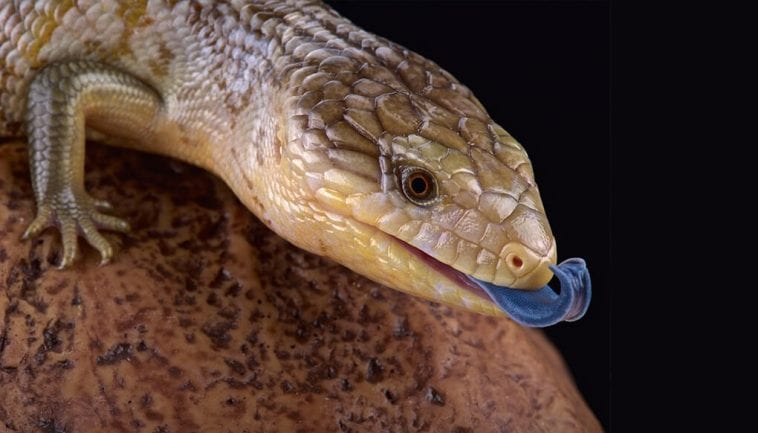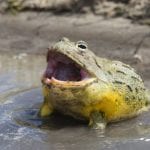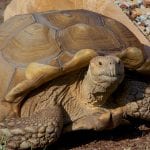Scientific Facts
| Common Name | Blue-Tongued Skink |
| Scientific Name | Tiliqua scincoides intermedia |
| Life Span | 15 to 20 years |
| Size | From a few inches (hatchlings) to 2 feet as adults |
| Habitat | Sandy soil |
| Country of Origin | Australia and Indonesia |
Physical Description
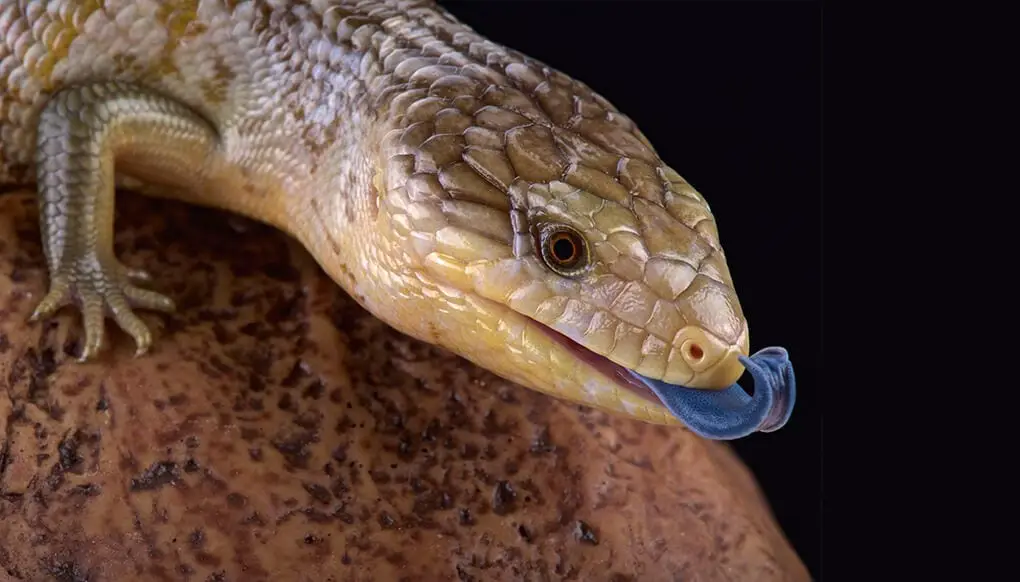
As the name already suggests, what is most striking and noticeable about the Blue-Tongued Skink is its bright blue tongue. You could easily tell this species of reptiles apart from all of the other lizards by simply looking at its tongue. While there are some reptiles with a blue forked tongue, the Blue-Tongued Skink tends to have one that comes in a strikingly bright color that is really hard to miss. They usually protrude their tongue more often than normal when they are in defense mode or when they feel threatened. So, if you happen to see the tongue well enough, there is a chance that this reptile feels a bit of aggression coming from you.
The head of a Blue-Tongued Skink is wedged and has colors and patterns that can be distinct from its neck. Moreover, the top of the head is slightly flattened compared to other reptiles with rounder tops. Meanwhile, the ear openings tend to be conspicuous enough for you to see them. And when you see their teeth, you will notice that they are not too long and sort of blunt. Blue-Tongued Skinks tend to have short legs. Their tails are also short and are usually not longer than the body.
Speaking of their body, these reptiles generally have large and long bodies that are covered by smooth and shiny scales. They are usually greyish or brownish in terms of color and have symmetrical horizontal patterns that follow from the tail up to the end of the body just before where their necks start. The patterns or the bands are darker in terms of color. In some way, their color scheme is similar to that of a python but what makes them look different are the patterns draped across their bodies.
Types
There are actually different types of Blue-Tongued Skinks. The types depend on where they are native to.
Classic Indonesian
The Classic Indonesian Blue-Tongued Skinks have a striking body coloration that is yellowish. Meanwhile, the bands that surround their body have a solid black color that is similar to their limbs.
Halmahera Indonesian
The Halmahera Indonesian is almost the same as the Classic Indonesian but they are usually reddish in color instead of yellowish. Nevertheless, the other features such as the black marks and the black limbs are the same.
Kei Island
Kei Island Blue-Tongued Skinks look like they have freckles on their face. They are closer to an orangey kind of brown in terms of color.
Irian Jaya
Technically still Blue-Tongued Skinks, the Irian Jaya variety is the black sheep of the species. They are light brown in terms of color but have auburn or dark orange bands that cover their bodies.
Merauke
The Merauke have freckles in their arms and legs, have a light brown body with auburn-colored bands, and an orange belly. These types of Blue-Tongued Skinks have really long bodies and are generally calmer than most other types.
Tanimbar
The Tanimbar Blue-Tongued Skinks are some of the most physically striking types. You can usually see them in a yellowish kind of color and tend to have shiny or glossy scales.
Blotched
The Blotched are native to Australia and can live up to 30 years. They also tend to be some of the longer varieties of Blue-Tongued Skinks and can reach lengths of more than 2 feet. You can distinguish them from all other types because of the striking patterns of yellow and orange covering their backs.
Centralian
Centralians are native to the central part of Australia. They are shorter than Blotched and have stouter bodies and larger heads than normal. As such, those features make their arms and legs look shorter than other types of Blue-Tongued Skinks. They are usually light brown or light yellow in terms of color. Meanwhile, the bands or patterns on their backs are dark yellow or orange.
Eastern
As the name suggests, Easterns are native to the eastern portion of Australia. They can grow to up to 2 feet and are the most common types of Blue-Tongued Skinks. They have light brown bodies covered by dark brown bands.
Northern
The Northern Blue-Tongued Skinks are regarded as the most popular types anywhere in the world and are the ones that are kept as pets or for captive breeding. They look similar to the Easterns but they have grey forelimbs and yellowish or orange oval markings on the sides of their bodies.
Lifespan
Blue-Tongued Skinks usually live longer than most other pet reptiles, which have a lifespan of somewhere near 10 years. In this case, the Blue-Tongued Skinks live somewhere close to 20 years. In some cases, there have been reports of such reptiles living close to 30 years. If your Blue-Tongued Skink only lives for about 15 or so years, then there must be a problem with the way you took care of them. In that case, if you want them to live north of 20 years, it is vital that you know how to properly care for these reptiles.
Eating Habits
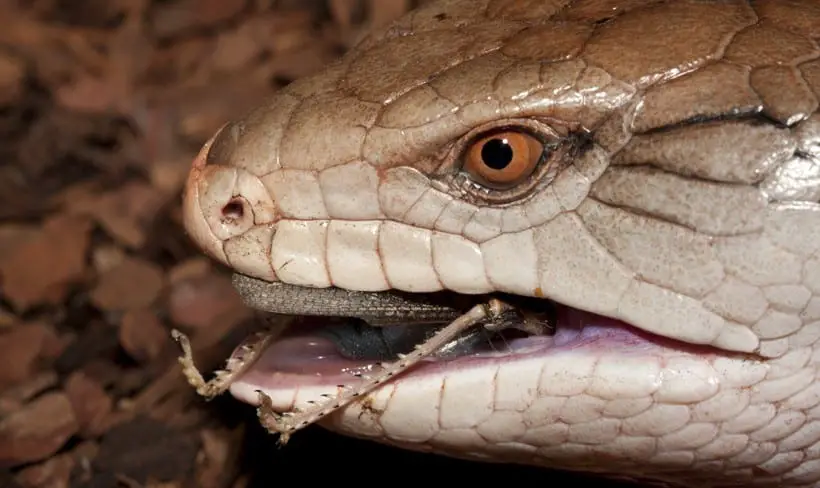
Blue-Tongued Skinks are mostly carnivorous in nature as they love to hunt for insects when they are left alone to fend for themselves in the wild. Crickets, grasshoppers, worms, snails, and almost any other insects are regular parts of a Blue-Tongued Skink’s diet. In some cases, these reptiles even prey on smaller lizards and rodents. As long as they can get their hands on it and that the prey is small enough for them, Blue-Tongued Skinks will eat them.
However, in reality, Blue-Tongued Skinks are actually omnivorous and can eat fruits and vegetables especially when they are kept in captivity. In that sense, these reptiles should be given a balanced diet that is composed of meat, fruits, and vegetables if you want them to thrive and live long in captivity. Of course, the proportion of fruits and vegetables they eat as against their protein intake should very much vary depending on their age.
Hatchlings or Blue-Tongued Skinks up to about three months old should be fed regularly and almost every single day. These young reptiles need to have a diet composed of about 70 to 80% protein to help their muscles grow well. Meanwhile, juvenile Blue-Tongued Skinks of about 3 to 8 months old need to eat thrice a week.
As Blue-Tongued Skinks get older, they should be fed less often to prevent them from getting obese. Moreover, their diet should be composed of about 50 to 60% protein only. They should be getting 30 to 40% of their food from vegetables. The rest should be fruits. Most adult Blue-Tongued Skinks should be fed only once or twice a week.
Aside from insects, the best protein source you can give Blue-Tongued Skinks are eggs, ground poultry meat, and mice or fish as treats only. For vegetables, give them lots of greens and make sure to avoid spinach, broccoli, and lettuce. Berries, peaches, apples, and similar fruits are good for these reptiles but avoid feeding them seeds.
Sleeping Habits
Blue-Tongued Skinks are diurnal creatures that tend to be active during the day and less active during the night. This means that you should not worry about them at night when you are also sleeping because, chances are, they are also sleeping or are at least not so active. It is normal for younger Blue-Tongued Skinks to be sleeping all day because it helps them grow. The older they get, the more active they become but not too active. They would still prefer to take naps from time to time during the day after finding a good spot to borrow through.
Water
Tap water is perfectly safe for Blue-Tongued Skinks as long as it is also safe for drinking for humans. You should use a large water bowl as a water source for your reptile because of how they tend to soak their bodies in water to make it easier for them to shed and to stay hydrated. Go for a dish that is no deeper than 3 inches. Having a large water dish of about 9 to 10 inches does not only provide a good hydration source for your Blue-Tongued Skinks but it also helps in maintaining the humidity level in their enclosure.
You should make sure to change their water every 2 days especially when it gets dirty. Blue-Tongued Skinks love to defecate in their water source, so be sure to disinfect the entire dish after taking it out to prevent illness.
Development and Reproduction
Telling females apart from males can be a bit tricky when it comes to the Blue-Tongued Skink. However, males tend to be a bit larger compared to the females. Their heads are bigger and their tails are also thicker if you measure the base. In some cases, the males have a brighter shade of orange compared to the females. Nevertheless, such features are not always conclusive when it comes to telling them apart. You may need to go to an expert to really assess whether your Blue-Tongued Skink is either male or female.
In most American and European regions, people tend to breed their Blue-Tongued Skinks during the spring season somewhere in March to May right after their hibernation period, which is usually around November to February. The Indonesian types of Blue-Tongued Skinks do not have a typical hibernation period but they still do breed better during the dry seasons.
How to Breed
The best way to breed your Blue-Tongued Skinks is to place them together in a large enclosure during the springtime. This is when you will see if they are compatible with one another. You might see the male freezing in his place for a while before trying to make his move. And when he makes his move, he is an aggressive reptile. It will be common for the male to bite and to claw his way to the female just to get a good mounting position for mating.
Blue-Tongued Skinks tend to be solitary creatures that spend most of their lives isolated from their kind. In that sense, the female’s demeanor can be somewhat defensive during mating season when the male becomes too aggressive. Be careful when handling them and try not to get your hands on the reptiles when things get a bit too rough. But if you think that the aggression becomes too much to the point that injuries might possibly happen, it is best to separate the two.
It is normal for the female to suffer injuries during the mating process. However, the female will eventually submit to the male and will raise her tail as a sign that she is ready for mating. After that, try to weight your female as much as you can and see if her weight is increasing. If she is getting heavier, that means that she is pregnant. Give her the nutrition she needs to develop healthy and thriving baby Blue-Tongued Skinks.
Common Health Problems
Like any other reptile species, Blue-Tongued Skinks also have common health problems that can pose a risk to their overall health and lifespan. As long as you know these problems, you will be able to equip yourself with the proper tools and information to prevent these health issues as much as possible.
Metabolic bone disease
This health problem usually arises in Blue-Tongued Skinks kept in captivity. The reason why it is so common for such reptiles is that the phosphorus to calcium ratio tends to be out of balance especially when they are not receiving the right kind of light or when they are under a poor diet. If your Blue-Tongued Skink is suffering from such a disease, you will notice an overall weakness in your reptile. They will be feeling lethargic, lazy, and unmotivated. Fractured bones can be common as well.
Parasitic infections
Parasitic infections are quite common in Blue-Tongued Skins. These reptiles will usually suffer from intestinal parasites as a result of stress especially when they are the types that were captured from the wild. Healthier Blue-Tongued Skinks usually have strong enough immune systems to prevent the parasites from overpopulating the body. However, when they are under a lot of stress especially when captured ones are still in the middle of adjusting to an entirely new environment, the immune system might weaken and the parasites might overwhelm their body. Symptoms of internal parasitic infections include loss of appetite, weight loss, lethargy, and diarrhea.
Meanwhile, mites are the most common external parasites your Blue-Tongued Skins can suffer from. These mites will suck the blood out of your reptiles through their skin. Symptoms of mites can include rubbing, lethargy, weakness, prolonged soaking, and loss of appetite.
Respiratory infections
Respiratory infections are actually very common among reptiles. These are usually caused by bacterial infections in the lungs. The most common reasons for such infections are cold weather, low or high humidity, and stress. Symptoms can include wheezing, weepy eyes, loss of appetite, runny nose, and open-mouth breathing.
Preventing Illness
The best way for you to prevent illnesses in your Blue-Tongued Skinks is to make sure that they are given the right conditions in their enclosure. The temperature, humidity, and sanitation should be up to par for what such reptiles need to be able to live comfortably and healthily. Of course, you yourself should also make sure that you know what you are doing and that you sanitize yourself when handling them. Your hands can be a common way of transmitting parasites such as mites. So make sure you sanitize your hands before handling them. Proper sanitation of their water dish as well as of their entire enclosure are also vital.
If it is impossible to avoid illnesses, make sure you get your Blue-Tongued Skink to a vet right away. Keep a list of veterinarians that are capable of handling reptiles because not all vets are trained and knowledgeable when it comes to exotic types of animals such as Blue-Tongued Skinks as well as other types of reptiles.
Behavior
Blue-Tongued Skinks are not the most active of reptile species. In fact, one can easily say that they were simply not made to be active types of reptiles. They are quite docile, quiet, gentle, and even submissive at times. This makes it easy for most pet owners to tame Blue-Tongued Skinks. Despite their docile, quiet, and gentle nature, Blue-Tongued Skinks are easily threatened when they feel a bit agitated. These are defensive creatures instead of aggressive ones. As such, when they feel like they need to defend themselves, they will hiss, bite, and expose their tongues as a means of showing that they are not afraid.
By exposing their blue tongues, these skinks can defend themselves well from predators. They are slow and heavy creatures that do not have a lot of other tools that could allow them to perform well in battle. As such, they use their tongues to scare any potential threat as the blue color is a bluff of sorts to make their enemies think that they carry a potent poison.
Nevertheless, as long as you handle your Blue-Tongued Skinks a lot, they will recognize you as their owner or as a more dominant creature. As such, they will become more passive and friendly towards you and might not feel agitated or defensive towards you. This will make it easier for you to tame and pet them. They will noticeably gaze at you from time to time in a friendly manner. What that means is that they will be open for some bonding sessions with you.
Hibernation Cycle
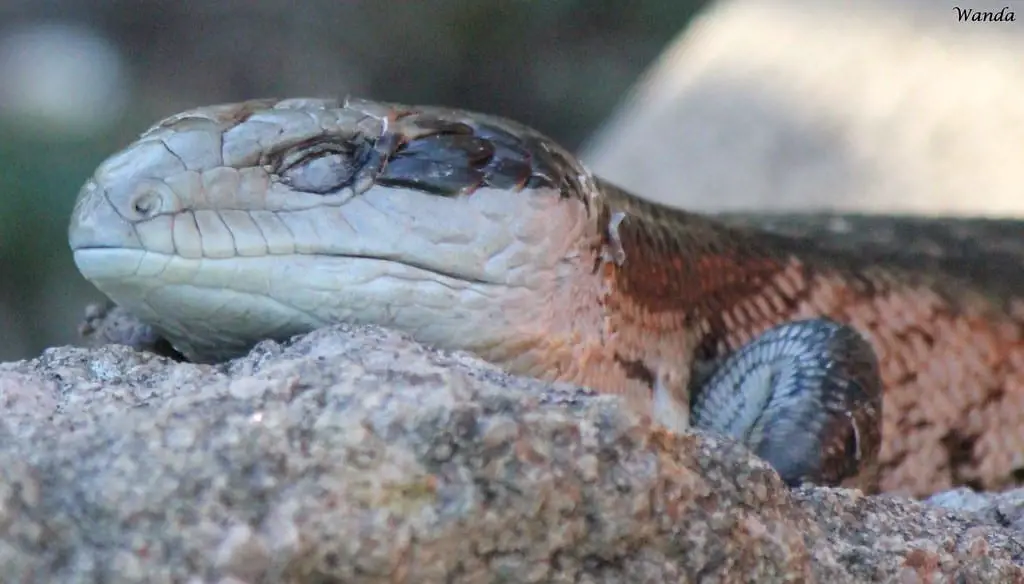
Hibernation is encouraged in Blue-Tongued Skinks especially during the cold winter seasons of October to February. During this time, you will notice that their activity level will drop dramatically. As such, feeding should be decreased to once every two weeks because of how they will hardly ever move during this time. You are also encouraged to drop the temperature in the enclosure to allow your Blue-Tongued Skink to hibernate easier. This will go on for about four months. After the period of hibernation, gradually raise the temperature level back to normal and make sure to feed them regularly again.
Shedding
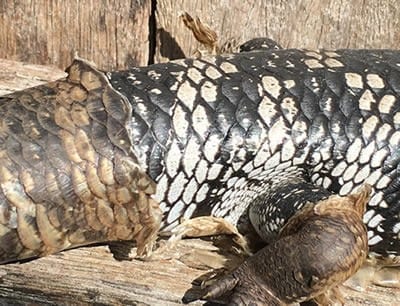
It is perfectly normal for the Blue-Tongued Skinks to shed a lot because it is their nature as reptiles. They will shed as they grow. That means that the younger Blue-Tongued Skinks will shed more often than older ones because they are in the process of continuous growth. They will most likely rub their skins on a rough surface to make shedding easier. Also, on top of that, it is also easier on their part to shed when their skin is hydrated. To that end, you should make sure to keep a large water dish to allow your reptile to drench their body in water. This will make it easier for them to shed their old skin away.
Habitat
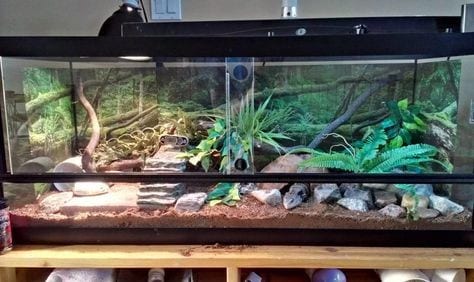
The enclosure of a Blue-Tongued Skink should ideally be a terrarium that is about 4 feet long, 2 feet wide, and a foot and a half deep. The large size of the enclosure is to allow the reptiles to roam around freely during the day when they are at their most active. You can even place hatchlings in an adult-sized terrarium because they tend to love to hide as a means of feeling safe and secured from potential predators.
You may need a minimum of 8 feet of floor space to house your Blue-Tongued Skink. Also, make sure that the terrarium has a front opening to make it easier for you to access the interior. There should be a lid that is solid enough to prevent the reptile from escaping but not too solid as to prevent air from entering the enclosure. The important part is to make sure that the top is securely latched to prevent the skink from trying to escape.
Go for a wooden terrarium if you want to trap or hold heat really well. Unfortunately, molds tend to develop easier especially when the humidity levels are high. Meanwhile, glass is easy to clean and very nice to look at. But it isn’t the best at retaining heat.
Lighting and Humidity
Use heat lamps to light your enclosure because Blue-Tongued Skinks are used to regions that are quite hot. An ultraviolet B or UVB light might be a good option for you because this type of lamp also provides your reptile with the vitamins they need to balance out their phosphorous and calcium levels. You may need only two lamps. It is preferred that you use a UVB lamp at the cool end of the enclosure and a heat lamp over to where your reptile usually loves to bask. These lizards do not need a light source at night because they tend to stay active only during the day.
In terms of humidity, make sure that the terrarium is quite humid and has an average humidity level of somewhere between 40 to 60%. This makes it easier for your Blue-Tongued Skinks to shed their skin. It also keeps them hydrated while they are basking under the heat of the lights. The best way to help keep humidity levels consistent is to mist the enclosure using a sprayer. You can also use a large watering dish to help keep the humidity high enough for your reptile.
Temperature
Blue-Tongued Skinks prefer an environment that is quite hot due to how they are commonly found in regions with high temperatures. These cold-blooded reptiles rely on heat to keep their bodies warm and to function well. In that sense, make sure to provide them with a lot of heat in their terrarium. A heating lamp is the best way to do so. Make sure to put the heating lamp in their basking area, which requires a temperature of about 100 to 105 degrees Fahrenheit. The rest of the enclosure can stay somewhere over 85 degrees.
At night, it is normal for the Blue-Tongued Skink to feel a bit cold. That means that you might not need to provide them with the heat at night. So long as temperatures do not drop lower than 65 degrees at night, things will be perfectly fine for your reptile.
Sanitation
Blue-Tongued Skinks have a habit of defecating on their water source. So make sure to replace the water once every two or three days. You should also disinfect the dish to make sure that no bacteria stays in place. Speaking of bacteria, try to clean out their terrariums regularly as well. And when you are handling your reptile, make sure you disinfect your hands too to avoid getting mites on them.
Natural Environment – Substrate
The substrate or bedding you can use for your Blue-Tongued Skink’s terrarium can be mulch that can be a bit deep because these reptiles love digging and hiding for shelter. However, the humidity of the substrate also depends on the type of Blue-Tongued Skink you have. Australian species, who are used to the dry desert conditions of Australia, need dry substrates. Meanwhile, those that come from the wet areas of Indonesia require humid substrates.
Hydration
Blue-Tongued Skinks do love to drink a lot of water to keep their internals hydrated. At the same time, they also love submerging their entire body in water to keep external temperatures cool and to make shedding easier. That means that you should keep a large water dish in their terrarium. Preferably, keep it large enough to allow the reptile to submerge its entire body. The large water dish also allows you to control the humidity levels better.
Availability – Where to Get One?
There are plenty of exotic pet shops in your locality or online that sell Blue-Tongued Skinks. However, most of those that captured skinks sell Indonesian varieties because of how Australia has banned the export of exotic creatures to the rest of the world. But if you get your hands on an Australian variant, it was most likely bred in captivity from parents that were captured before the ban.
How to Care for a Blue-Tongued Skink?
Here are some tips on how to care for a Blue-Tongued Skink:
- Blue-Tongued Skinks are extra defensive especially when they are adjusting. You can tell that they are agitated when they show their tongues a lot. That means that you should give them time to adjust before you try to handle them. But once they do adjust to you, they are friendly and quite affectionate towards their owner.
- Keep their enclosures warm because Blue-Tongued Skinks are used to regions that are quite hot. Use a heating lamp to provide them with the heat they desire but also use a UVB light to balance out their phosphorous to calcium ratio so that you will be able to prevent any associated illnesses.
- A healthy and balanced diet is one of the keys to making your Blue-Tongued Skink thrive well. That means that you should not solely feed it with protein coming from insects and meat but also lots of fruits and vegetables to provide them with a balanced and nutritious diet.
- Keep your hands clean when handling them so as to prevent mites from attaching to your Blue-Tongued Skinks. Mites are tiny black parasites that can easily suck blood from the skin of your reptiles. They are very easy to miss because they are so tiny and can be mistaken for dirt.
FAQs
How big should Blue-Tongued Skinks enclosures be?
Blue-Tongued Skinks are somewhat on the large side and can be quite active during the day. That means that you should provide them with an enclosure that is large enough for them and is about 8 feet in total space occupied so that they will be able to enjoy a large area where they can roam around whenever they feel like it.
Are Blue-Tongued Skinks solely for experienced owners?
It really depends because Blue-Tongued Skinks are not really difficult reptiles to handle but can be tricky for those who have no experience when it comes to breeding. That means that these creatures are best for those with a bit of experience in handling reptiles and other forms of exotic pets.
Are Blue-Tongued Skinks friendly?
Blue-Tongued Skinks are generally friendly towards their owners once they have adjusted to life in captivity. That said, those who are new to handling one should best be careful because these reptiles can easily feel agitated and defensive towards faces they are not familiar with.
Are Blue-Tongued Skinks active?
Blue-Tongued Skinks are diurnal and are active during the day but can easily feel lazy. They tend to be far less active whenever its nighttime and are often found sleeping whenever it is dark.
Are Blue-Tongued Skinks dangerous?
They generally are not because Blue-Tongued Skinks are not poisonous. Their bites are not even made for piercing or tearing because of how flat their teeth are. But you should still be careful of their bites because of their strong jaws.
Are Blue-Tongued Skinks aggressive?
Blue-Tongued Skinks generally are not aggressive creatures and are usually defensive. They will show their tongue and display a bit of dominance whenever they feel like you are aggressive towards them.
Why do Blue-Tongued Skinks have blue tongues?
The Blue-Tongued Skins have tongues that are colored blue for defensive purposes. This allows them to show their tongues to their potential attackers and to make them feel threatened by the color blue, which will make any aggressor think that they are poisonous creatures.
Are Blue-Tongued Skinks affectionate?
Blue-Tongued Skinks are one of the rare types of reptiles that are quite affectionate towards humans in the sense that they even resemble mammals because of how affectionate they are. That said, they will only show affection if they are already used to you as they are somewhat defensive types of reptiles that will show agitation towards anything that threatens them.
Is hibernation normal for Blue-Tongued Skinks?
Since Blue-Tongued Skinks live in areas where climates can change quickly and where temperatures can drop seasonally, it is perfectly normal for them to hibernate during the cold seasons from October to February. In fact, hibernation should be encouraged since that is the very nature of these reptiles whenever the season gets too cold for them to function normally.
Can Blue-Tongued Skinks eat normal pet food?
Yes, they can. Blue-Tongued Skinks can eat normal pet food such as a dog or cat food as they contain essential nutrients that even these reptiles need to survive. It is best to pair dog and cat food with vegetables to provide your Blue-Tongued Skinks a healthy and balanced diet instead of one that is composed of pure protein.

